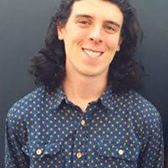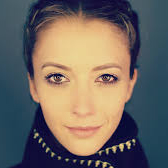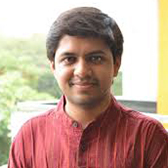Jessica Chobot: I’m Jessica Chobot and this is AI Hype VS. Reality, an original podcast from Dell Technologies. I’m in New York, and I’m about to take the stage to perform a sitcom written with an AI bot in front of a live audience. But first, I’m going to meet Jamie Brew the guy behind all of this.
Jessica Chobot: Hi, Jessica.
Jamie: Hi, Jamie.
Jessica Chobot: Nice to meet you. So what are we doing today.
Jamie: Today we’re gonna write a scene from a predictive text sitcom, from family sitcoms from the 80s and 90s mostly.
Jessica Chobot: Oh okay, so ones I’m very familiar with.
Jamie: This came from just looking at-
Jessica Chobot: Predictive text or?
Jamie: Yeah, just from looking at the predictive text bar on any smartphone. If you just make that a game, and strictly keep choosing one of those three options. You write these sentences that are like- I have a lot going on in my life but I think it will be good for me to get a new car and It sounds-
Jessica Chobot: That sounds like perfect, like it makes perfect sense. So have you ever done a sitcom before, and performed it, or is this the first time?
Jamie: This is the first time we’re gonna be predictive text sitcom.
Jessica Chobot: Oh really? To a live group yeah?
Jamie: That’s right. You’re gonna be a writer and you’re gonna be in the cast.
Jessica Chobot: All right cool, sounds good. I’m terrified.
Jamie: Great lets do it.
Jessica Chobot: All right.
Jamie: The family show is filmed in front of [inaudible 00:01:18] in New York. The family show, interior school hallway, older sister is at her locker putting away her stuff.
Jessica Chobot: Hold on, hold on before we hear anymore of how that performance turned out, let’s pick apart the hype from the reality when it comes to AI and creativity. Everything from advertising to fashion design will be completely driven by AI. Arts of all kinds, including music, books, and even fine art will be conceived, written, performed by AIs with no human involvement. No job is safe from being automated, even those in the creative class, and all of this is going to happen any day now.
Jessica Chobot: As always I am joined by resident AI guru Dave Graham director of emerging technologies and messaging at Dell technologies. You’ve heard the hype around creativity and AI so what is your reality check. Is current AI capable of replicating human creativity? Let’s answer the question in this podcast, what is art?
Dave Graham: Well at the risk of offending many, many people I’m not gonna answer that. In all seriousness creativity is- you know the expression beauty is in the eye of the beholder, right? Creativity is very much the same way, what constitutes creativity? Nvidia for example recently released a software program, or an AI program, that said you can draw stick figures and we’ll suddenly compose landscape scenes that are almost picture realistic. Now it means my eleven year old can sit there and doodle and suddenly turn into Monet. When I look at that, or I look at anything that’s been generated there I perceive it in the way that I want to perceive it without knowing who created it at all.
Jessica Chobot: Well creativity of course is very nebulous I don’t know how we’re gonna actually get to the bottom of it in this podcast, but we are sure gonna try. So who did you talk to when it comes to AI in creativity as a whole?
Dave Graham: All right so, first, I wanted to take a look at how fine art paintings, drawings, and that sort of thing are influenced by AI, so I spoke with Harshit Agrawal, he’s and artist who’s primary medium is not watercolors or pastels its machine learned. He creates paintings in installations with AI, and he’s all about the continuum of creativity between people and AI.
Harshit Agrawal: In some sense the creative outputs that we have are a collection of all the things we’ve been experiencing, been through, and that’s exactly what the machine does. I did a piece called Tandem where the machine is chained on a collection of millions of images of all kinds of things in the world. So it’s built up of visual understanding of the world in a way similar to what an average human mind. What I do with Tandem is I get someone to, a human, to do a doodle or a random sketch and then the machine takes that random sketch and interprets what it sees within that to then complete the paintings.
Harshit Agrawal: This person drew trees without leaves and the computer imagined them as dogs with large ears. So it drew like a dog face, at the center of the bark and sort of the branches became these ears. So that’s something that no other human being would have imagined. For me personally I’m definitely much more interested in how I can use AI or machine learning to augment my sense of creativity or to give me new interesting ways of sorta making art, making experiences.
Jessica Chobot: I find it interesting also that, that AI didn’t necessarily create anything on its own, it still needed a human element with the humans own creativity to bring that through. So this is just essentially a really high functioning paintbrush or pencil or whatever it is that you want to equate it to some artistic tool.
Dave Graham: Goes down to- there’s always these fun things- Is math art? Right, so I mean if you look at the underpinnings of AI there’s algorithms. Are algorithms art? Is the development of them art? If you see these things to you as the consumer of it, or the recipient of it or perceiver of it, it may not be, but to those who create and I think that’s really what it’s striving for and to your point Jessica. He’s kinda doing this meta creation thing, he’s letting his pallet be developed by something that he’s put time, effort, and energy into, and its evoking something.
Jessica Chobot: Yeah and I like that you mentioned math, because I feel like that flow can go both ways. It’s not one side or the other necessarily being the instigator because you have something like the golden ratio for an example which a lot of painters from the renaissance era and throughout have used to format their paintings in a specific way and that is very much in, like deeply in math. So then aside from that who else did you talk to?
Dave Graham: So next I wanted to find out more about AI in music so I went and talked with Pierre Barreau the co-founder and CEO of AIVA. AIVA is an artificial intelligence that writes music for soundtracks, video games, TV shows, and any kind of entertainment.
Pierre Barreau: AVIAs like a machine learning algorithm, a deep learning algorithm that takes as input 30,000 different scores of history’s greatest composers, so Mozart, Bach, Beethoven. It reads all those scores of music and it will try to infer some musical rules, like rules of rhythm, melody, harmony, and so forth. Then once its learned all those rules its able to actually create a totally original piece of music. So for example we may say okay I like the Moonlight Sonata of Beethoven I’d like to compose a piece of music that sounds- that has the same emotional characteristic as that piece of music. So I think the idea that music can be mathematical is no so scary it’s more like Mozart used to roll dices in order to- the act of throwing dice telling him to compose in a specific way. Honestly, what I think computers are good at is creating a lot of ideas, but then really the role of the musician or the composer is to interpret those ideas and give them meaning.
Jessica Chobot: This particular topic hits really close to home because back in I would say the early 2000s when I went to art college the fine arts department would be getting in an argument with the illustration department and the computer illustration department because nobody respected the computer illustrators because it was not real art, but then all the computer illustrators and illustration department would roll their eyes and say that the fine artists were snobs because it of course it is art. We were as students, stuck in the middle and kinda just left to hang until society caught up with what science was doing. It was very interesting.
Dave Graham: Yeah, I mean what’s the nature of synthesizers right? Its keys that you press its math that’s created through a DSP and its music that’s outputted for it. It requires an input. We can use like Pierre was saying we can use history to inform the musical palette again we’re painting with a different palette here its music this time. We’re gonna process it through this thing but it’s all been derived based on the original intent which was to create something.
Jessica Chobot: Right. Well thank you for your insights Dave once again. I’m gonna take that idea of creatively working with AI and instead of being afraid of it like my professors I’m gonna take it down to a club in New York for a live, yes live, performance of a sitcom written by a comedy bot. So while I’m not afraid of what the comedy bots gonna do I am afraid of my own performance.
Dave Graham: Well best of luck to you on that one Jessica.
Jessica Chobot: Thank you.
Jessica Chobot: But before I head to New York I’m going to hear the story behind the first album every composed and produced with AI.
Taryn Southern: My name is Taryn Southern and I am a technologist and storyteller.
Jessica Chobot: Taryn is also the woman behind I am AI. As the first truly AI album it was a lot of work just getting it off the ground.
Taryn Southern: First, I had to hound all of the founders of these technology companies because a lot of the software was not yet publicly available. I reached out to everyone that I could. Learned how to use each one of the different pieces of software and then set out on my experimentation.
Jessica Chobot: But what is actually involved. What is it actually like to try to compose music with an AI?
Taryn Southern: You start by setting a number of different parameters such as genre, mood, BPM, instrumentation early on in the beginning of making the album I really wanted to combine a cinematic orchestral mood with pop. It was choosing instrumentation like cellos or violins and then mixing them with synthesizers and other more electronic pop elements.
Jessica Chobot: So how did composing with an AI differ from composing on your own?
Taryn Southern: In real life I don’t really play instruments very well I can plunk out a few keys on the keyboard. Barely create a few odd chords. So when I have to make a song on my own I have to augment my own skills by working with other humans of course. Producers, instrumentalists, whatnot. The tricky part with that of course is that it really, for someone like myself it was limiting in terms of how much I could create how quickly I could create and how I could even identify my own style and preferences on my own. So a lot of times I think I would sort of take the back seat in the music creation process.
Jessica Chobot: So AI put Taryn in the driver’s seat.
Taryn Southern: I was making all the editorial changes, iterating as many times as I needed without worrying about tiring someone out or going past my budget, and I think that’s really the core difference. But in many ways it felt very similar in the sense that I had a creation partner there was a process of back and forth almost like improv.
Jessica Chobot: Ah, nice foreshadowing there Taryn of what I’m about to do. Anyway, having been through the process for the first time ever working with an AI to compose and album can an AI really be creative?
Taryn Southern: Ultimately whether or not the machine is creative is almost irrelevant. They can be used as incredible tools for augmenting, or substituting, or transforming human creativity, and ultimately it is the human that is in the driver’s seat. That’s in the directors chair, and making all of the decisions
Jessica Chobot: So does Taryn think this is the dawn of a new era in human AI creativity?
Taryn Southern: Over the next five, ten years we’ll see a huge expansion upon those capabilities. I’m really excited about the ability to be able to sing a melody that I hear in my head then give the AI parameters around how to create music around that melody and then be able to sift through interesting variations of music that allow me to just create vocal melodies and lyrics.
Lyrics from Taryn’s song: I’d swallow swords and juggle fire, jump across electric wire, pierce my nose and dye my hair, ride a bull and fight a bear.
Taryn Southern: I think its an amazing thing to be able to express ones self with the proper tools and you have to look at a lot of the world doesn’t have music education doesn’t have the arts embedded in their formative years. My goodness I have actually learned more about the music creation process by working with AI than I ever learned in the sort of the 10 years making music with other people.
Jessica Chobot: Well I’m about to put Taryn’s AI creativity optimism to the test.
Jessica Chobot: All right so were down in the gallery slash basement of a building in New York City and we’re sitting in the writers room which is a big long table with a bunch of laptops and I’ve got other guests here. Hi everybody, Jessica.
Comic 1: Hi Jess [crosstalk 00:13:46]
Jessica Chobot: Nice to meet you. Hello, nice to meet you.
Jamie: Hey I’m Jamie.
Jessica Chobot: Jamie I know you already. So I guess let’s just get into it, what do I do because this just looks crazy to me.
Jamie: So on all of these screens we have a version of voice box which is our predictive text keyboard and each of these interfaces is gonna suggest words that are specific to a different kind of character in sitcoms.
Jessica Chobot: All right.
Jamie: There is one for Older Sister who’s a composite of older sister characters in a bunch of different sitcoms. There’s one for love interest and there is Romantic Rival, who is another girl at the school a popular bully. Each of these keyboards suggest lines that are specific to that character type and were gonna be first casting you three as these three characters and then co writing a scene with those three characters through these predictive text keyboards.
Jessica Chobot: So remember these predictive text keyboards are powered by like a bazillion sitcoms from the 80s and 90s making it the ultimate sitcom AI writing machine.
Jessica Chobot: So I see that you have assigned me the role of Romantic Rival, which is the snotty girl in the school so I feel like I can potentially pull this off. Who are you gonna be?
Comic 2: I think I’m more of an Older Sister type.
Comic 1: And I’m clearly Love Interest so I’m gonna be the love interest.
Jessica Chobot: Awesome.
Jamie: He’ll be reading the stage directions which once we have our dialogue were gonna write to tie the scene together.
Jessica Chobot: I guess how do I get started with choosing these words, cause I’m just looking at this computer monitor and I see like three rows of about five to six words and they change every time I click on them.
Jamie: Yeah, each of these 18 words is a word that is likely to begin a sentence that a romantic rival character says in a sitcom.
Jessica Chobot: Would say.
Jamie: If we choose one of those words just like if you were choosing a word on predictive text on your phone, then a new screen of words shows up which are the words that are likely to come after.
Comic 2: I think the biggest mistake that you can make trying this for the first time is trying to be too prescriptive and plan what your character is gonna say, we have a general idea of the scene but I think just good to start clicking and making things that are grammatical sentences and sort of seeing where it takes you, cause sometimes then you find and idea that you didn’t even have in the first place.
Jessica Chobot: Oh, I got another winner. Not even thinking your love lawyers will have anything I will.
Comic 2: Great.
Jessica Chobot: Got that right.
Jessica Chobot: Just a second, I’m jumping in here because I don’t want you to hear any more before the actual performance, so spoilers and just to be clear while I am a TVM podcast host and I’ve done plenty of stuff on camera I’m not an actor, I’m not a performer, and I have serious stage fright, and at this point as the room is filling up because there’s a ton of people here I’m really starting to wonder if putting myself in the hands of an AI sitcom writing bot was a great idea.
Jamie: Is that working? That’s working. Welcome everyone thank you for coming out to television night with botnick in the basement of Babycastles. The family show, interior school hallways, older sister is at her locker putting away her stuff.
Comic: 2 -Sigh- The same city, the same mold, the same reality I’m so beautiful and I can’t take it anymore.
Jamie: Romantic rival approaches
Jessica Chobot: Its miserable enough to be here in this bad part of town, and now you have to mess up my life?
Comic 2: The world is not going to embarrass me I’m doing a great life.
Jessica Chobot: You don’t care why I’m sorry about how hard you worked.
Comic 2: Just because I’m an emergency waitress doesn’t mean I can make you an egg in the hall.
Jamie: Love interest enters.
Comic 1: Hey there older sister and the other thing. You love to be with me every single day.
Comic 2: Do you know where to get the thermometer to tell me how amazing you are?
Comic 1: You have no idea what you don’t understand.
Jessica Chobot: Not even thinking your love lawyers have anything I will.
Comic 1: Well my bike is the cutest girl I know, but you two are pretty cool for human beings. Convince me that you are my sunshine.
Comic 2: You set me on fire with your eyeballs, oh let’s go find a really small room just large enough to have two sexy people in it.
Jessica Chobot: You know what she’s a pain mess and chronic enough to fight.
Comic 1: My friends dreams are a curse, please, let me play a motorcycle solo for you.
Jamie: And that brings us to the end of our scene we’re cutting it to somewhere else but we haven’t written it yet. So give it up for the family show cast and the family show band. On the family show.
Jessica Chobot: So I’m really glad that that’s over from a nervous perspective. With that being said, I legit thought that it turned out a lot better than I was expecting super funny, true laugh out lough moments, and just kind of this weird feeling of comradery alongside the people that I wrote with. So Hype VS Reality how does it stack up? Overall I don’t think AI is anywhere close to the point where it’s going to overtake human creativity, that being said it’s an excellent tool to expand creativity as a whole. That’s AI Hype VS Reality from Dell Technologies and to see what that sitcom performance actually looked like be sure and check out delltechnologies.com/hypeVreality
Jessica Chobot: Next time on the podcast can AI replace doctors and nurses and actually do a better job at keeping us healthy, stay tuned.
 Dave Graham
is the director of emerging technologies messaging at Dell Technologies and specializes in AI and social transformation.
Dave Graham
is the director of emerging technologies messaging at Dell Technologies and specializes in AI and social transformation.
 Jamie Brew
is the co-founder of Botnik Studios, a digital company that specializes in artificial intelligence-assisted interactive comedy.
Jamie Brew
is the co-founder of Botnik Studios, a digital company that specializes in artificial intelligence-assisted interactive comedy.
 Taryn Southern
is a youtube star and the first musician to use AI to make entire album.
Taryn Southern
is a youtube star and the first musician to use AI to make entire album.
 Pierre Barreau
is the CEO and Co-founder of AIVA (Artificial Intelligence Virtual Artist) virtual composer, which is an AI composing soundtrack music.
Pierre Barreau
is the CEO and Co-founder of AIVA (Artificial Intelligence Virtual Artist) virtual composer, which is an AI composing soundtrack music.
 Harshit Argawal
is a Human Computer Interaction Researcher, Artist, Creative Technologist and MIT Media Lab alumnus. Agrawal builds tools to study how technology can blend with and enhance human creative expression.
Harshit Argawal
is a Human Computer Interaction Researcher, Artist, Creative Technologist and MIT Media Lab alumnus. Agrawal builds tools to study how technology can blend with and enhance human creative expression.